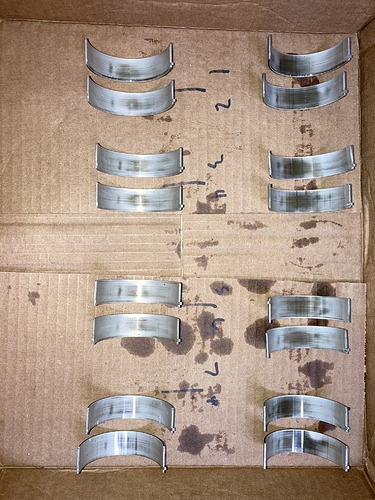Posting these picture here of the Rod bearings pulled from the 27k motor, once again the Blackstone Oil analysis came back good so I would say this is normal for an RS5 at this mileage. The top row are the upper bearings that show a little more wear than the lower.
That doesn’t look too bad but I’d wish it was better at 27k miles. I’ll be at 50k in the next month and I drive it like I stole it. Those clearances you found were definitely on the skinny side and worry me a little. Did you end up getting more clearance data?
Specs for the Conrods clearances are:
New: 0.020 … 0.069 mm.
• Wear limit: 0.120 mm.
Strange but talk about consistency, all 8 Conrods with the new bearings pretty much spec’d at 0.051mm plus or minus 1 or 2 thousandths. Waiting on my new Snapon 3/8" drive digital Torque wrench that also does degrees so there is no guessing and I will get them Torqued to the final specs.
That’s wonderful
Also throwing on my reason for the new Snapon wrench. I did buy a nice bolt stretch gauge that I’m going to use but I’m not using my new ARP rod bolts. ARP and pretty much every engine builder says if you are using any aftermarket bolts that are supposed to be stronger, which ARP definitely are, you would then need to resize your Rod big ends. That would necessitate the Rods being out of the engine. So I purchased a new set of OEM Rod bolts that just arrived today, along with the new King Rod XPC rod bearings.
Another sad RS5 CFSA story. Don’t know all of the details but the user and I have spoken by PM. Sounds like a Rod bearing for sure to me. Don’t know all of the details as far as mileage, Oil change intervals, type of oil, cleanliness, etc…
Sheesh. I run mine hard as hell too. I’ll be switching to 3000 mile oil changes I guess. If mine ever blows up I’m 4.0tt swapping it or selling it.
From many oil analysis I’ve seen I think with a top quality oil your good to about 5~6k miles. An oil analysis will really tell you how your oil is doing and whether you should change it more often or if you can run it a little longer and it’s fairly cheap.
I am wondering what role or to what proportion unburnt fuel contamination plays in the engine failures and early camchain wear. Was considering the HPFP (high pressure fuel pumps) as there are accounts of those (sometimes catastrophic) and I thought the oil smelled a bit much of fuel as I last changed. My over consumption of fuel compared to previously has, however, been constant for 4-5 years and the same for the oil consumption. Fortunately, now olcheck oil lab is back (in EU) so can be tested at next change. Judging from the state of the oil, as I can measure, I definitely second the idea of 4000 or so mile oil changes or at least once a year.
Hi @hahnmgh63 @Ape_Factory and everyone else interested. I got a sample back using a similar oil to what @RS5 is using. Looks like the engine is in similar condition to his? The high titanium value must come from the oil, it is the Castrol FST Titanium oil after all and I do not know where it would come from otherwise. Thinking about creating thread with or for just RS5 oil samples
5357234 whiteouty 2.pdf (2.3 MB)
I can’t think of any titanium internal parts in the CFSA motor. Generally, if titanium is used, it’s for intake valves, rods, and connecting rod bolts. Neither are titanium in the RS5’s engine.
That is pretty standard from the newer Castrol oil. The Titanium is an additive that both Castrol and Kendall Oil have been adding to their oil in the last 5+yrs. The analysis overall looks pretty good. Not sure when you pulled the oil but do you drive a fair amount of short trips? The 1.6% of fuel is a little on the upper end but not too high. A sign of driving shorter trips and the oil not getting up to full/hot temperature and/or a cold start to move the car just before the oil change?
Cheers, yes, I think maybe it is because the car has been sitting over winter until the sample was taken and before did some short trips only. It makes about 15 centiliters of fuel if my math work out right. That said, I have smelled fuel before that on taking off the oil cap, so I guess might be leaking some from the HPFPs for instance. Within acceptable bounds as I take that as another reason to stick to shorter oil change intervals.
I also did a “cheat-half” carbon clean on that oil where I pulled the upper intake with the engine still reasonably hot and spray CRC into the closed cylinders then brush and syringe it out. It is a lot easier to get the hoses off when warm but there is coolant coming out of one of them in the original setup. Took me 30 minutes to do largest surprise of this ownership. Not sure if any of the resulting carbon or CRC making its way into the engine oil would show up as fuel.
Lastly, I was expecting more water in the oil (the car not moving over winter) – seems to hold pretty tight if that is a useful metric, I don’t know, but would be cool if it is.

